This article has been just updated: January 15, 2024
Virtually every electronic device we use today connects to the internet through a wireless router. Yet, most people rely on a budget router supplied by their internet service provider without ever considering upgrading to a better router, one that can provide faster download and upload speeds, excellent coverage, cutting-edge parenting and security features, and lots of other perks.
If you’re ready to ditch your old router for a new one, our list of top 7 best wireless routers of 2024 will help you find a router that can satisfy your needs without breaking your budget.
1. Asus ROG Rapture GT-AC5300
The Best Gaming Router in 2024
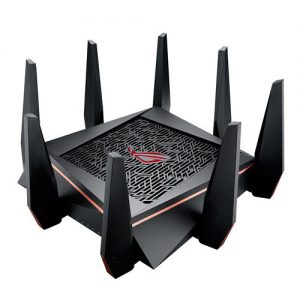
MSRP: $399 | Speed: AC5300 | LAN Ports: 8 | Antennas: 8
The Asus ROG Rapture GT-AC5300 is a powerful tri-band wireless router designed specifically to meet the needs of hardcore online gamers who won’t settle for anyone else than a single-digit ping.
Features:
-
- The router is packed with cutting-edge wireless technology, including Game Dashboard, which provides a real-time heads-up about all of your devices and connections.
- The router is also equipped with an advanced intrusion prevention system powered by Trend Micro, protecting you from external attacks and threats even if your PC’s security software isn’t turned on.
- Inside the Asus ROG Rapture GT-AC5300 is a top-of-the-line 1.8GHz 64bit quad-core CPU that dwarfs most gaming PCs of the last decade and allows the router to easily handle multiple simultaneous connections.
2. Asus RT-AC68U
The Best Budget Router
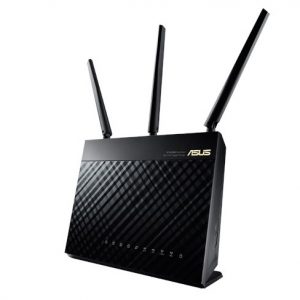 MSRP: $140| Speed: AC1900 | LAN Ports: 2 | Antennas: 3
MSRP: $140| Speed: AC1900 | LAN Ports: 2 | Antennas: 3
If you’re not keen on spending hundreds of dollars on a new wireless router but still want to enjoy fast data transfer rates and excellent coverage, then you should consider the Asus RT-AC68U, which is often sold for around $100.
Features:
-
- This dual-band router is powered by a dual-core processor that eliminates the performance drops that plague budget routers.
- It features two USB ports for file and printer sharing, and you can turn the router into your personal cloud storage hub thanks to Asus AiCloud.
- Robust parenting controls help you keep your children safe from inappropriate online content, giving you total peace of mind when your children explore the internet.
3. Netgear Orbi AC3000 Tri-Band Wi-Fi System
Easy Setup Wireless Router
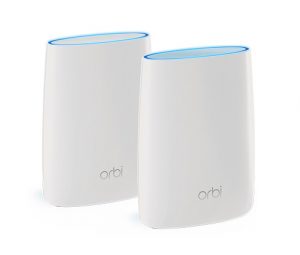
MSRP: $399 | Speed: AC3000 | LAN Ports: 3 on base unit, 4 per node | Antennas: 6
Netgear Orbi is an easy-to-use mesh Wi-Fi system that makes it easy to cover your entire house with strong Wi-Fi and say goodbye to dead zones. Mesh Wi-Fi systems like the Netgear Orbi consist of a main router that connects directly to your modem, and a series of satellite modules or nodes.
You can start with a single Orbi Wi-Fi router and add nodes over time, depending on your needs. A single Orbi Tri-band Mesh Wi-Fi router can deliver speeds up to 2.2 Gbps, allowing you to enjoy 4K online content and smooth gaming.
4. Linksys EA8300 Max Stream
Best for Medium-size Homes
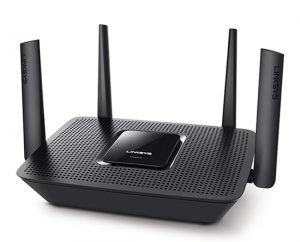
MSRP: $199 | Speed: AC2200 | LAN Ports: 4| Antennas: 4
The Linksys EA8300 Max Stream is a relatively affordable tri-band router with support for the latest Wireless-AC technology for simultaneously streaming and gaming on multiple devices.
Features:
-
- When paired with Max-Stream Range Extenders, the router enables your devices to automatically switch to the strongest Wi-Fi signal as you move around your house.
- Apart from fast wireless connectivity, the Linksys EA8300 Max Stream also offers four Gigabit Ethernet ports that let you connect more devices and share files at blazing speeds.
- You can control the router using the Linksys smartphone app, which works on all Android and iOS devices.
5. Asus Blue Cave
Best Router for Smart Homes
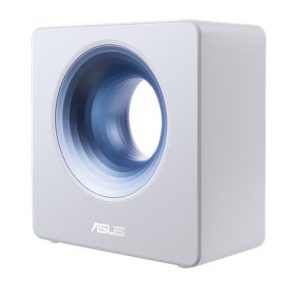
MSRP: $179 | Speed: AC2600 | LAN Ports: 4| Antennas: 4
It’s safe to say that the Asus Blue Cave is the strangest-looking wireless router on the market today. Resembling a Dyson fan, this unique router is powered by Intel Wi-Fi technology, giving it the power to handle the simultaneous demands of multiple connected devices in your home.
The Blue Cave protects all connected devices from online threats and features advanced parental controls that let you easily filter out inappropriate online content. The router is compatible with Amazon Alexa, and it supports Asus AiMesh technology for creating a flexible whole-home Wi-Fi network.
6. Google Wifi
Easy to install and manage
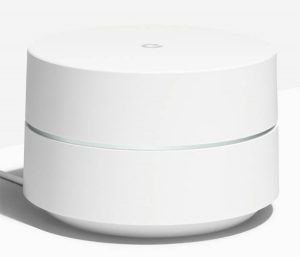
MSRP: $299 | Speed: AC2600 | LAN Ports: 1 on base unit, 2 per node
The Google Wifi is a mesh Wi-Fi system from the company behind your favorite search engine. It’s designed to reduce dead zones and provide you with fast download and upload speeds.
A single Google Wifi device can cover one small home or apartment, and three Google Wifi devices working in unison can cover up to 4,500 square feet. You can control, configure, and set up your Google Wifi using the Google Wifi app, which is available on Android and iOS.
7. Netgear Nighthawk X10
Best router for video streaming or surfing
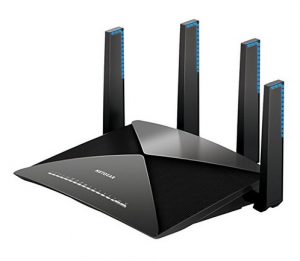
MSRP: $499 | Speed: AC1900 | LAN Ports: 7| Antennas: 4
Not all wireless routers are meant to be tucked in some corner, hidden from view. The Netgear Nighthawk X10 is a winner of the Red Dot Design Award, which is an international product design and communication design prize awarded by the Design Zentrum Nordrhein Westfalen in Essen, Germany.
Features:
- Besides its elegant, futuristic design, the Netgear Nighthawk X10 also offers an ultra-smooth, lag-free Wi-Fi experience thanks to its powerful 1.7 GHz quad-core processor and support for 802.11ac and 802.11ad Wi-Fi technology.
- Plex, a media server that allows you to aggregate all your personal media and access it anywhere you go, is supported right out of the box, which is just one extra reason why the router is worth the steep price.
How to Choose a Wireless Router
You don’t need to be a networking expert to choose a wireless router, but there’s a couple of things you should know about wireless networks before you take out your credit card and enter your PIN.
Modern electronic devices can wirelessly access the internet thanks to the IEEE 802.11 set of wireless computer networking standards. This standard dates to 1985, and there have been many revisions over the years.
-
- 802.11: The original IEEE 802.11 standard was published in 1997 and clarified in 1999. It offered a maximum data rate of only 2 Mbps over the 2.4 GHz band.
-
- 802.11b: Using the same media access method defined in the original standard, the 802.11b standard increased the maximum data rate to 11 Mbps, which led to its rapid acceptance as the definitive wireless LAN technology at the time.
-
- 802.11g: In 2003, the 802.11g standard was ratified, operating at a maximum data rate of 54 Mbps exclusive of forward error correction codes, or about 22 Mbps average throughput.
- 802.11n: In 2009, the IEEE published an amendment that improves upon the previous 802.11 standards by adding multiple-input multiple-output antennas (MIMO) and support for the 5 GHz band. As a result, the maximum data rate increased to 600 Mbps.
- 802.11ac: This latest amendment to the original IEEE 802.11 standard includes wider channels, more spatial streams, and the addition of Multi-user MIMO (MU-MIMO), which enhances the MIMO technology by enabling the simultaneous transmission of multiple streams to different Wi-Fi devices. The maximum data transfer rate of 802.11ac is 1300 Mbps.
As you might have guessed by now, the newer version of the IEEE 802.11 standard a router supports, the better. Virtually all routers today support 802.11n regardless of their price, and mid-range and budget models with 802.11ac are becoming increasingly common.
Even if none of your electronic devices supports 802.11ac, it’s still a good idea to pay extra for a wireless router that supports this standard because it’s very likely that your next smartphone, smart TV, or even smart fridge will as well.
FAQ
What are the top 7 best wireless routers released in 2024?
The best wireless routers of 2024 that stood out for their performance, features, and user satisfaction include the Netgear Nighthawk AX12, Asus ROG Rapture GT-AX11000, TP-Link Archer C4000, Google Nest Wifi, Linksys Max-Stream MR8300, TP-Link Archer A7, and D-Link Exo AC3000.
What made the Netgear Nighthawk AX12 a top choice in 2024?
The Netgear Nighthawk AX12 offered cutting-edge 12-stream Wi-Fi 6 technology, which significantly improved speed, network efficiency, and connected-device handling. It was praised for its performance and range that catered well to large houses and multiple devices.
Why was the Asus ROG Rapture GT-AX11000 popular among gamers?
Gamers appreciated the Asus ROG Rapture GT-AX11000 for its triple-level game acceleration, prioritizing game packets from the device to the game server. It also offered impressive tri-band speeds and advanced configuration options.
How did the TP-Link Archer C4000 stand out in 2024?
The TP-Link Archer C4000 stood out due to its tri-band capabilities, delivering consistently fast speeds across multiple devices. Its range-boosting technology and user-friendly interface made it a favorite for households with a mix of Wi-Fi needs.
What feature made Google Nest Wifi unique among the best routers?
Google Nest Wifi combined a Wi-Fi router with a smart speaker, providing mesh networking functionality alongside Google Assistant support, which allowed voice control and simple smart home integration.
What was the highlight of the Linksys Max-Stream MR8300 mesh router?
The Linksys Max-Stream MR8300 was noted for its easy setup and seamless room-to-room roaming, thanks to its capability to set up a mesh network when paired with other Linksys devices. Its performance was robust for a mid-tier model.
For those on a budget, how did the TP-Link Archer A7 fare in 2024?
The TP-Link Archer A7 was a standout budget-friendly option that offered solid performance for a standard-sized home. It included useful features like parental controls and support for Amazon Alexa voice commands at a very attractive price point.
What made the D-Link Exo AC3000 a competitive router in 2024?
The D-Link Exo AC3000 brought to the table high-speed tri-band performance, comprehensive parental controls, and enhanced security features with a built-in McAfee antivirus to protect connected devices.
How important was the introduction of Wi-Fi 6 with these 2024 routers?
The introduction of Wi-Fi 6, or 802.11ax, was critical in 2024 as it signified a leap in wireless communication technology, promising higher speeds, better management of multiple devices, and improved overall network efficiency.
Were mesh networking features prominent in the best wireless routers of 2024?
Yes, mesh networking features were becoming more widespread, with systems like Google Nest Wifi and the ability to expand the Linksys Max-Stream MR8300 into a mesh network, addressing the need for seamless coverage across larger spaces without signal drops.
Did any of the top routers of 2024 include built-in cybersecurity features?
Yes, for instance, the D-Link Exo AC3000 included a comprehensive built-in cybersecurity suite powered by McAfee, offering users additional peace of mind concerning the security of their devices and data.
How did these top routers handle the growing number of connected devices in homes?
These routers, especially those supporting Wi-Fi 6 like the Netgear Nighthawk AX12, were designed to handle growing numbers of connected devices more efficiently through improved bandwidth management and enhanced network protocols.
What role did the tri-band technology play in the routers’ performances?
Tri-band technology, seen in routers like the Asus ROG Rapture GT-AX11000, allowed for one 2.4GHz band and two 5GHz bands, enabling more devices to connect at faster speeds while minimizing interference and congestion.
Was affordability a consideration in the top 7 routers of 2024?
Indeed, products like the TP-Link Archer A7 offered a balance of performance and affordability, making sure there were options for those who did not wish to invest heavily in cutting-edge technology but still needed reliable Wi-Fi.
What kind of user interface did these routers provide for easier setup and management?
Many routers like the Google Nest Wifi and Linksys Max-Stream MR8300 came with user-friendly interfaces and accompanying mobile apps, ensuring an easy setup process and simplified network management for users.
How did parental controls factor into the functionality of 2024’s routers?
Parental controls were a significant feature for families, offering the ability to manage internet access and content restrictions for children, as seen in routers like the TP-Link Archer C4000 and D-Link Exo AC3000.
Could these routers be integrated with smart home systems?
Yes, routers like the Google Nest Wifi supported smart home integration with built-in Google Assistant, while others offered compatibility with Amazon Alexa and IFTTT for convenient smart home automation.
What kind of warranty or support could users expect with these top routers?
Manufacturers of these top routers typically offered at least a one-year warranty, along with customer support through various channels such as phone, email, or live chat to assist with troubleshooting and setup.
Did these top routers support guest networking for additional privacy and security?
Yes, guest networking was a common feature across these models, allowing users to create separate networks for visitors to keep the main network’s traffic private and secure.
Was there a notable router among the top 7 that focused more on range than speed?
The Google Nest Wifi particularly emphasized range through its mesh capability, extending Wi-Fi coverage across different rooms and floors without compromising speed substantially.





